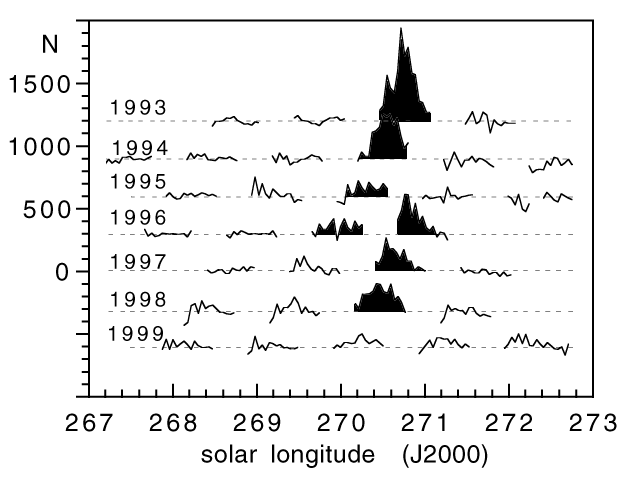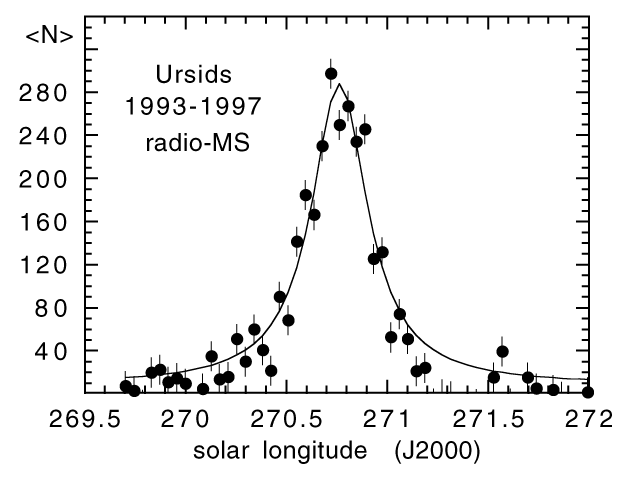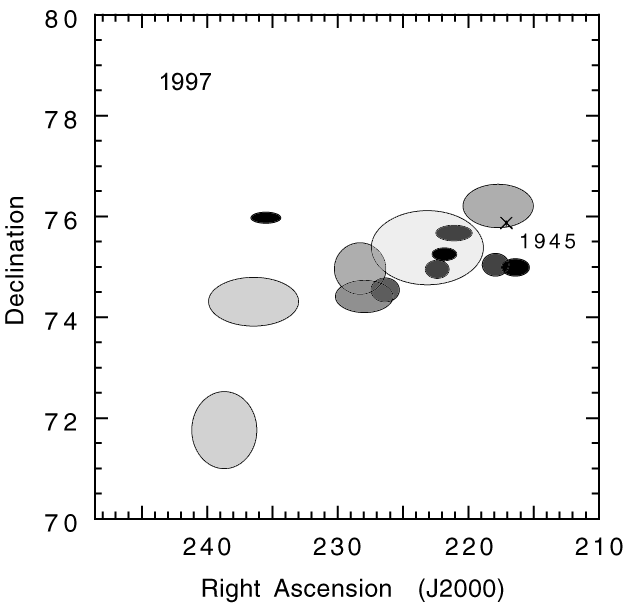Possible Ursid outburst on December 22, 2000
Peter Jenniskens,
SETI Institute at NASA Ames Research Center, MS 239-4, Moffett Field, CA 94035, USAEsko Lyytinen,
Kehäkukantie 3 B, 00720 Helsinki, Finland______________________________________________________________________________
Abstract.
The Ursid shower has broad Filament-type outbursts around the perihelion passage of parent 8P/Tuttle, but also isolated narrow outbursts at aphelion. We calculated Tuttle's dust trail encounters in the same way as for the Leonid showers. We discovered that it takes 6 centuries to change the orbit enough to bring the meteoroids to Earth's orbit. During that time, the meteoroids and comet separate in mean anomaly by 6 years, thus explaining the unusual aphelion occurrences. We predict enhanced activity on December 22, 2000, at around 7:29 UT.______________________________________________________________________________
1. Introduction
During a cold winter night in December of 1986, Norwegian observers Kai Gaarder and Lars Trygve-Heen saw a spectacular outpour of Ursid meteors over a period of 3 hours [1]. A similar outburst had been reported by visual observers at Skalnaté Pleso Observatory in 1945 [2,3]. These Ursid outbursts are very unusual, because they occur when the parent comet 8P/Tuttle is near aphelion. The comet orbital period is about 13.6 years. At the time of this writing, in early December 2000, it is only a few months before the comet will reach aphelion again.
|
|
|
|
Figure 1a - Ursid Filament as observed around perihelion passage of comet 8P/Tuttle (1994) by forward meteor scatter. Counts (N) are raw reflections after subtraction of daily background. Data: I. Yrjölä/Global-MS-Net. |
Figure 1b - The mean activity profile after correction for observability. |
2. Ursid Filament
Let us first examine other recent Ursid showers to show the unusual aspects of these aphelion outbursts. The annual shower component has ZHRmax = 8. On top of that, there are frequent outbursts when the comet is near perihelion (Fig. 1). In 1994, the comet passed 0.061 AU outside of Earth's orbit. In December 1993, Bob Lunsford observed the ascending branch of an outburst from Mt. Laguna, California, to ZHRmax = 100 (r = 2.5). Japanese observer H. Shioi observed the peak in 1994 [4], from which we have ZHRmax = 50 (r = 2.6). In 1996, rates were still elevated at ZHRmax = 25 [5], and of order ZHRmax = 16 in 1997.
Similar outbursts were observed during the previous return of the comet, by Japanese observers in 1981 [6] and by Jos Nijland and Hans Breukers of the Dutch Meteor Society in 1982, who observed the descending branch starting at ZHR ~ 35. These perihelion outbursts occurred at a significantly different point in the orbit than the 1986 outburst, about 6 hours earlier, and were significantly wider. We have B = 2.5±0.5 [1] or a Lorenz curve width of W = 0.35±0.05o. In 1997, we obtained thirteen outburst Ursid orbits from two-station video observations in California (Table 1). These show significant scatter of radiants with a wide range in Right Ascension, more than in Declination, even without 3 possible outlayers (Fig. 2, Tab. 1).
|
|
|
|
|
Figure 2 - Radiants of 1997 Ursids. |
Table 1 - Ursid orbits (J2000) from the 1945 outburst [3 - recalculated] and as observed from California during the 1997 Ursid outburst (P. Jenniskens, M. Koop; calculations M. de Lignie). |
3. Outbursts at aphelion
Even though the Ursid shower was among many other minor showers observed earlier visually by William F. Denning and Cuno Hoffmeister, and Denning even correctly associated the shower with comet 8P/Tuttle, it was the unusual outburst of 1945, observed by four observers at Skalnaté Pleso Observatory and reported by Antonin Becvár [2], that put the shower on the map. A young Zdenek Ceplecha calculated the orbit from the pinpoint radiant derived from three single station photographed Ursids and an assumed orbital period of the comet [3]. Ceplecha (priv. corr.) recalls: "It was a horrible amount of computations at that time. It was done by means of a mechanical computer with a handle, called "Odner". Nine decimal digits were kept in the calculations!" This result established the comet association. On request, Ceplecha checked the calculations with his current 486 PC (Table 1) and found the results still completely valid.
One remarkable feature of this outburst, as well as the more recent 1986 observations by Gaarder and Trygve-Heen (shown in Fig. 3), is that the shower stood alone. There was no outburst in 1946 [3] and no sign of an outburst in radio-MS data in 1987 [7]. Moreover, the stream is a factor of 6 narrower, with B = 17±3 rather than B = 2.5 or a Lorentz width of W = 0.05±0.01o. Note the difference in scale in Figures 1b and 3. Also, the magnitude distribution index may have been slightly steeper. From Kai Gaarder's magnitude estimates, we have r = 2.8 [1,7].
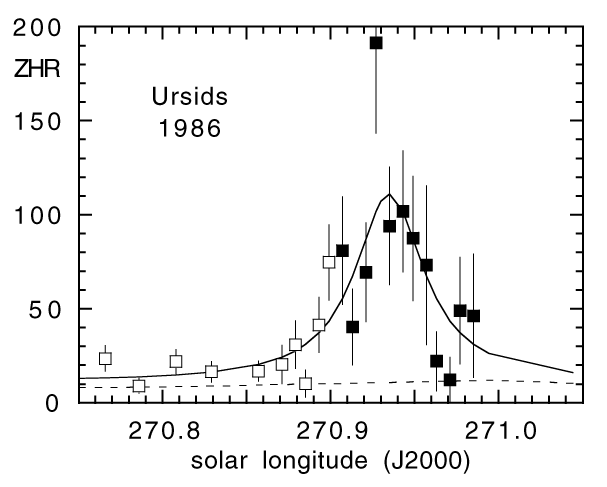
Figure 3 - ZHR curve of Ursid outburst in 1986 [1].
4. Model calculations for aphelion outburst
We submit that the broad 1981-82 and 1993-1997 perihelion outbursts are probably the accumulation of dust from multiple debris trails, with dust in orbital resonances, forming a structure much like the Leonid and Perseid Filaments of other Halley-type comets. This accumulation may have occurred over a relatively long period of time.
Given the much more narrow width of the aphelion outbursts, on the other hand, it is not unreasonable to argue that the material responsible for the 1986 outburst is not very old, and can probably be traced back to a single dust trailet. Similarly, the 1945 outburst might well be identified with a single dust trailet. That has the exciting prospect of predicting possible Ursid outbursts in December of 2000 and beyond, analog to recent predictions of Leonid returns [8].
8P/Tuttle has an orbit outside of Earth's orbit. For a meteoroid to hit Earth, the particle's perihelion distance (q) has to move inward to the Sun. As before, we calculated the orbital evolution of dust trails ejected over the past 800 years ending up in orbital resonances close to that of the comet. The comet currently librates around the "high" 13:15 mean motion resonance with Jupiter. A big number of the particles will get into slightly longer orbital periods and end up trapped in the mean motion resonances 12:14 or 6:7. Because it takes the particles longer to travel around the Sun, they will gradually move away from the comet. If at these resonances the librations are small, meaning that the particles will keep near the center of the "window", then there will be a systematic decrease of q more rapidly than for the comet itself. Near the leading edge of the resonance, the particles may have close encounters with Jupiter that will increase the perihelion distance instead.
We find that it takes about 6 centuries for dust to move close to Earth's orbit. During that time, the separation of the particles and comet in mean anomaly, as a result of the difference in orbital period, increases to 6 years. This is a natural explanation of why the 1986 and 1945 outbursts occurred about 6 years after the comet's closest encounter with Earth's orbit, or near aphelion. We also find that the resonances effectively confine the dust to a single year return, thus explaining the lone nature of the outbursts (Figure 4).
Inspecting the historic variations of q of the parent comet, we find maybe a dozen returns that could have resulted in a dust trail close to Earth's orbit at the present time. We examined a number of those trails to identify the ones likely to cause an outburst. Of course, many trails from encounters further back in time may contribute as well, but those should be less significant.
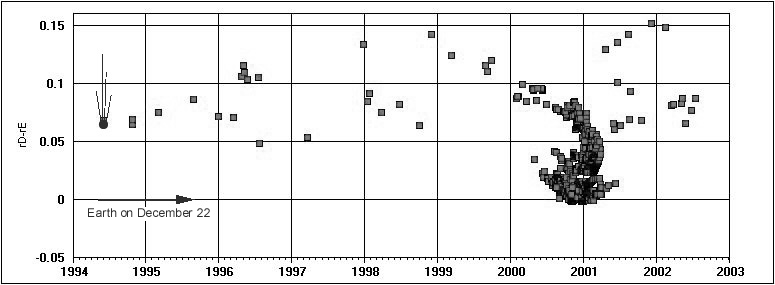
Figure 4 - Relative positions of particles from the 1365, 1378, 1392 and 1405 returns of 8P/Tuttle at the time of ecliptic plane crossing. Resonances effectively confine the dust to a narrow stream seen only in December 2000, 6 years after the comet's ecliptic plane crossing.
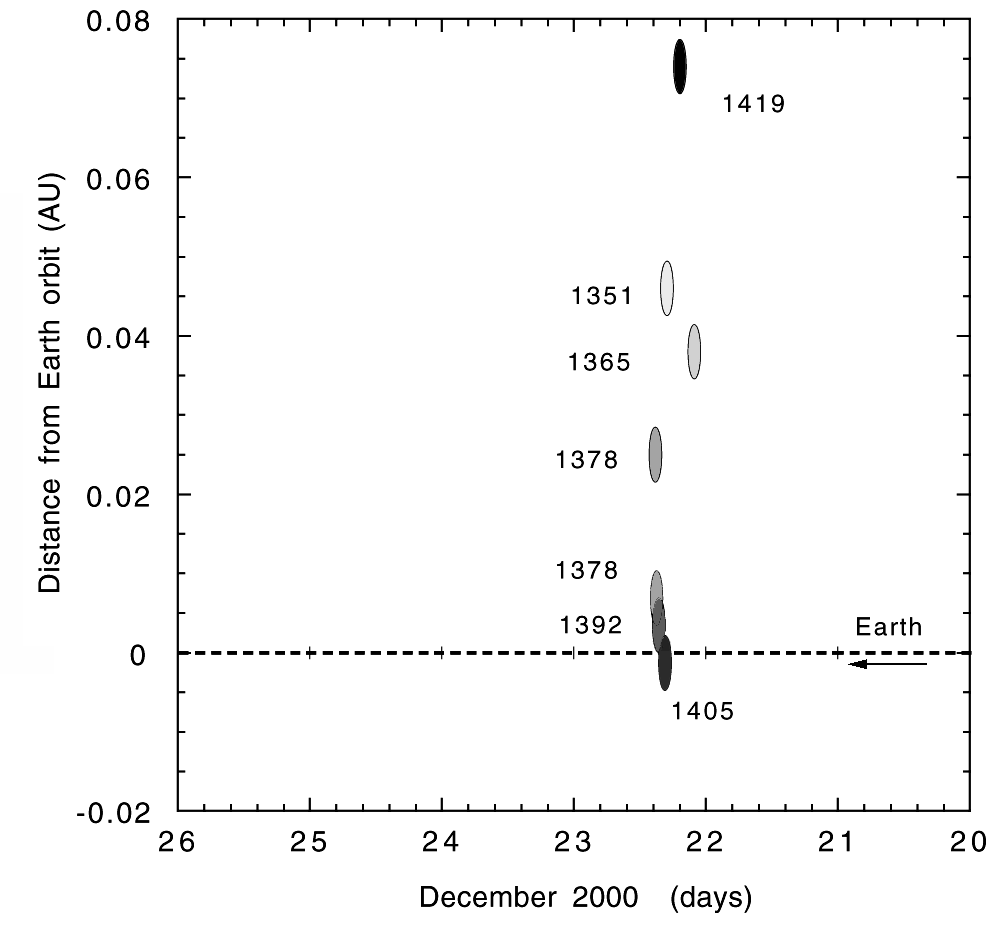
Figure 5 - Detail of Figure 4. Position of trails relative to the Earth's path (dashed line) in December 2000. The size of the ellipses is twice the full-width-at-half maximum as measured in section 3.
We find that a trail from dust ejected 44 revolutions back in the year 1378 is the likely source of the 1986 outburst. The trail comes close to Earth's orbit and the timing is to within 0.01o from the observed value. The same trail is near Earth's orbit as well in December of 2000, when the encounter occurs at solar longitude (B1950) 270.12, but at a distance of +0.0069 (and at 0.025) AU.
The dust from 1392 can account for the 1945 outburst, when the miss distance was less than 0.001 AU. This trail can perhaps produce a meteor outburst in December 2000 at solar longitude (B1950) 270.105. However, the miss distance (rD-rE) is again relatively large at +0.0035 AU (Fig. 5).
Rather, it is the next 45 rev. trail (to this year) of 1405 that is a prime candidate for an outburst in December 2000. It has a small rD-rE = -0.0013 AU at solar longitude (B1950) 270.056. This miss distance was confirmed in a more densely populated model.
Finally, we notice that the particles from many returns accumulate in the same 6:7 resonance "window". This process is perhaps responsible for the Ursid Filament.
5. Discussion: prospects for 2000 encounter
The solar longitude of the 1405 trailet passage in December 2000 corresponds to 7:29 UT. From recent Leonid observations, we measured a factor of 4 wider trail in the plane of the comet orbit [9]. That puts the Earth smack in the trail (Fig. 5). The particles of this trail are expected to be smaller than during past outbursts in 1945 and 1986, perhaps rather near the visual detection limit under good observing conditions. If the width is just a bit wider, the trailet of 1392 may show up at 8:38 UT. If so, these events probably make a continuous profile 4-5 hours wide, but can perhaps be recognized separately. Both events favor northern hemisphere observers in the America's. The Moon is out of the way providing for generally good observing conditions.
The expected intensity of the shower is hard to predict. Both the historic 1945 and 1986 encounters had the miss distances smaller than 0.001 AU, but the dust densities in the trail according to the mean anomaly factor seem to be smaller than in this year. Interestingly, the 1405 trailet piece actually seems to "start" only one day after the Earth encounter in 2000, where there is a turning point. At that point, the mean anomaly factor is locally quite high. We expect the A2 effect to smoothen this, so that dust is probably present during the December 22 encounter, but that, of course, will also lessen the density somewhat.
The 1378-dust (at 8:59 UT) should not be ignored. There is some uncertainty in the 1378 trailet position because the A2 effect has not been studied. This trail shows a relatively rapid increase of rD towards the end of this year. There seems to be quite a lot of these resonant particles present. Since there are particles around the rE only about a month or two earlier, it may even be that the A2 effect will help bring those near the Earth at the correct radii, if not otherwise.
Acknowledgements - We thank Ilkka Yrjölä for contributing his radio-MS observations to this work. We thank Mike Koop and other observers of the California Meteor Society for support of the 1994 and 1997 Ursid campaigns. We thank Marc de Lignie of the Dutch Meteor Society for calculating the Ursid orbits from multi-station video records, using software developed by Zdenek Ceplecha. Part of this work was supported by NASA's Planetary Atmospheres program.
References
[1] P. Jenniskens, "Meteor stream activity II. Meteor outbursts." Astron. Astrophys. 295, 1995, 206-235.
[2] A. Becvár, Circ. IAU No. 1026, 1946.
[3] Z. Ceplecha, "Umids-Becvar's Meteor Stream". Bulletin Astron. Inst. of Czechosl. 2, 1951,156-159.
[4] K. Ohtsuka, H. Shioi, E. Hidaka, "Enhanced Activity of the 1994 Ursids from Japan." WGN, the Journal of the IMO 23, 1995, 69-72.
[5] M. Langbroek, "Conspicuous Ursid rates in 1996." International Meteor Conference, poster presentation, 1997.
[6] K. Ohtsuka, "Expectation for enhancement of the Ursids activity in 1994", Tokyo Meteor Network Report no. 14, October 1994, p. 85.
[7] P. Jenniskens, "Ursiden 1987" Radiant, the Journal of DMS 10, 1987, 21-22.
[8] R.H. McNaught, D.J. Asher, "Leonid dust trails and meteor storms.", WGN, Journal of the IMO 27, 1999, 85-102; E.J. Lyytinen, "Meteor predictions for the years 1999-2007 with the satellite model of comets.", Meta Research Bulletin 8,33-40; E.J. Lyytinen, T. van Flandern, "Predicting the strength of Leonid outbursts", Earth, Moon and Planets 82-83, 2000, 149-166.
[9] P. Jenniskens, B.Å.S. Gustafson, "The rare 1932 dust trail encounter of 2000 November 17 as observed from aircraft", WGN, Journal of the IMO 28, 2000.
